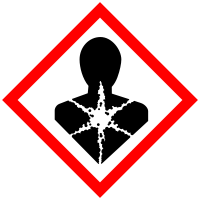
Photo from wikipedia
Nitroalkanes are organic aliphatic hydrocarbon compounds with a nitro moiety that are commonly used as solvents or intermediates to synthesize a variety of organic compounds due to their inherent reactivity.… Click to show full abstract
Nitroalkanes are organic aliphatic hydrocarbon compounds with a nitro moiety that are commonly used as solvents or intermediates to synthesize a variety of organic compounds due to their inherent reactivity. In June 2020, a harmonized classification and labeling (CLH) proposal was submitted to the European Chemicals Agency (ECHA) for the following harmonized carcinogenicity, mutagenicity, and reproductive toxicity (“CMR”) classifications for nitromethane (NM), nitroethane (NE), and 1‐nitropropane (1‐NP): NM Carc. 1B and Repr. 1B; NE Repr. 1B; and 1‐NP Repr. 2. In this assessment, a weight of evidence (WoE) evaluation of studies on animal carcinogenicity and reproductive and developmental toxicity, genotoxicity, and mode of action for these three nitroalkanes was performed to critically assess the relevance of the proposed CMR classifications. Overall, the WoE indicates that NM, NE, and 1‐NP are not carcinogenic, genotoxic, nor selective reproductive or developmental toxicants. Based on our analysis, classifying NM, NE, and 1‐NP as Category 2 reproductive toxicants is most appropriate. Furthermore, not classifying NE and 1‐NP with respect to their carcinogenicity is appropriate based on the available studies for this endpoint coupled with negative results in genotoxicity studies, metabolism data, and in silico predictions. We determined that the classification for NM of Carc. 1B is not appropriate, based on the fact that rat mammary and harderian tumors are likely not relevant to humans and lung and liver tumors reported in mice were equivocal in their dose–response and statistical significance.
Journal Title: Journal of Applied Toxicology
Year Published: 2021
Link to full text (if available)
Share on Social Media: Sign Up to like & get
recommendations!